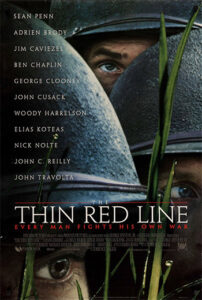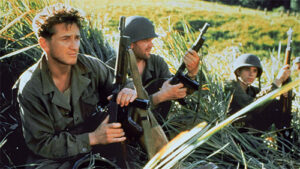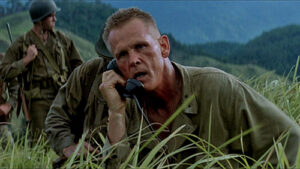 Love or hate him, Terrence Malick has a unique style. Personally, he’s not for me. The New World was a decent enough film, but it left me wanting more. I had such high hopes for The Tree of Life, only for it to result in one of my most frustrating and tedious theater-going experiences ever, that I was ready to write him off. However, there is often an anomaly. For me, it was his devastatingly beautiful portrayal of World War II in 1998’s The Thin Red Line. Rightfully or not, The Thin Red Line will forever be associated and compared with Saving Private Ryan, another World War II-based Best Picture nominee of 1998. And, if I’m being 100% honest, I did not know that Malick directed the Thin Red Line until after I finished watching it.
Love or hate him, Terrence Malick has a unique style. Personally, he’s not for me. The New World was a decent enough film, but it left me wanting more. I had such high hopes for The Tree of Life, only for it to result in one of my most frustrating and tedious theater-going experiences ever, that I was ready to write him off. However, there is often an anomaly. For me, it was his devastatingly beautiful portrayal of World War II in 1998’s The Thin Red Line. Rightfully or not, The Thin Red Line will forever be associated and compared with Saving Private Ryan, another World War II-based Best Picture nominee of 1998. And, if I’m being 100% honest, I did not know that Malick directed the Thin Red Line until after I finished watching it.
The ensemble for this film is like nothing I’ve ever seen. Adrien Brody, Jim Caviezel, George Clooney, John C. Reilly, John Cusack, Ben Chaplin, John Travolta, Nick Nolte, Sean Penn, Dash Mihok, Kirk Acevedo, Jared Leto, Thomas Jane, Tim Blake Nelson, and Woody Harrelson. Each of these actors could carry a movie on his own. As an ensemble, it was humbling (in a good way) to see how all of these A-list actors signed on, considering how few minutes of screen time each had. Some might criticize that these actors were underutilized or indistinct. This was purposeful by Malick, realizing that he had real-life faces that audiences remembered, allowing their roles to be more minor and murkier. It was a risky strategy, especially since it was adapted from James Jones’ 1962 novel, which had characters who were much more clearly defined. The battle scenes are expertly shot, making it feel like we are with the Allied Forces as they attempt to scale the hill, with each advancement resulting in ultimate costs.
The film follows parts of the Battle of Guadalcanal (an Allied military campaign fought between August 1942 and February 1993 on and around the island of Guadalcanal in the Pacific Ocean). We are with A group of young soldiers who are brought in as a relief for the battle-weary Marines. The period of this battle or the length we are with these characters must be clearly stated. What we do know is that soldiers are scared and unprepared for the hilltop assault, where bunkers are strategically placed, giving their Japanese enemies a decidedly clear advantage. However, the Allied Powers knew how crucial this victory was, as it would allow them to control a strategically positioned airfield, a 1000-mile radius, and break the Japanese’s last point of resistance.

If there is a single “main” character in the film, it is that of Private Witt (Jim Caviezel – The Passion of the Christ, Sound of Freedom). Witt is the character we meet first and the one we are with the most. Witt has gone AWOL in the South Pacific, living with Melanesian natives in the film’s first scene. The genuine smiling and glee that we see from Witt is fleeting. When he is discovered and returned to camp, his short-lived utopian paradise is no more. We don’t see him (nor any other character) experience this type of joy again.
Sergeant Welsh (Sean Penn – Dead Man Walking, Mystic River) is a level-headed leader who sees his job as a manager, keeping his men in line and performing their assigned tasks. He’s not so much a pessimist as he is a realist. His views often clash with Witt’s, though not in any antagonistic or adversary ways. Welsh doesn’t understand how Sitt can be so optimistic about the world or why he tried to evade duty. “In this world, a man, himself, is nothing. And there ain’t no world but this one.” Penn’s portrayal of Welsh is subdued for the most part and is a striking contrast to the soldier he depicted in his harrowing Casualties of War. Whereas Witt sees a lustrous, tranquil world where humans can coexist with nature by wafting the air, tasting the fruit, feeling the wind, touching grass and trees, and watching animals, Welsh sees the world as dark and war-ridden, and full of decay, brutality, and death. Malick continually shifts the perspective of these two characters to show how different soldiers can be from one another despite being assigned to the same battalion, batting the same enemy, with the same task at hand.

The most memorable scene involves Captain Staros (Elias Koteas – Shutter Island, NBC’s Chicago PD) and Lieutenant Coronel Tall (Nick Nolte – Warrior, The Prince of Tides). The two men are communicating through a field phone. Tall is instructing Staros to march his men up the hill. Staros is defying the direct order (with some of his men listening on) that he won’t do, calling it a suicide mission and insisting on going through the forest and flanking the enemy. The back-and-forth interaction is both captivating and uncomfortable. Both actors are fabulous in a conversation where each knows that Staros is likely correct in his assessment. However, Tall believes sacrificing the men is worth it if it means that Japanese soldiers will be killed in the process and, thus, advancing the mission.
The shifts between battle scenes and points of introspection are Malick’s most remarkable feat. Watching this incredible cast of actors take smaller roles to show the brutalities of war and who they are as men outside of the war, however purposefully limiting each’s exposure, having us know them a little. Still, at the same time, a mystery is a work of art. Despite being 1998 World War II movies, The Thin Red Line and Saving Private Ryan could not be any different in almost every aspect outside of the intense battle scenes. Saving Private Ryan earned 482 million dollars compared to 98 million for The Thin Red Line. Saving Private Ryan earned higher scores with critics and audiences (95% compared to 80%). Saving Private Ryan is the better movie (more intense battle scenes, a more advancing storyline, better-defined characters), but The Thin Red Line should receive a viewing from fans of war films. Know going in that The Thin Red Line has a much more nuanced pace and demands patience and uninterrupted concentration to be best appreciated.
Plot 9.75/10
Character Development 9.5/10
Character Chemistry 9.25/10
Acting 9.75/10
Screenplay 9.5/10
Directing 9.5/10
Cinematography 10/10
Sound 10/10
Hook and Reel 9.5/10
Universal Relevance 9.5/10
96.25%
Movies You Might Like If You Liked This Movie
- Platoon
- Saving Private Ryan
- Casualties of War
- Dunkirk
- Letters from Iwo Jima